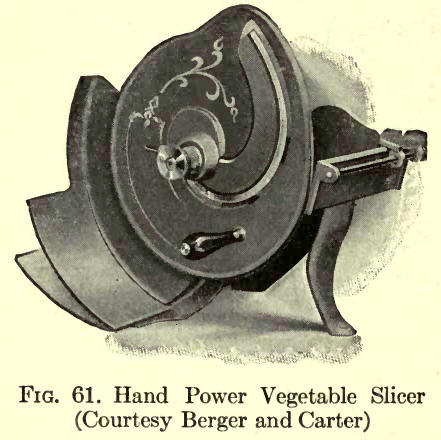|
Vegetables may be readily
sun dried in most climates but the quality of sun dried vegetables is
usually not so high as that of artificially dried vegetables. Sun dried
vegetables are usually exposed to attacks by insects, and insect eggs
are usually deposited upon them during drying. This makes it imperative
to sterilize vegetables that have been dried in the sun, to make certain
that they will not be destroyed by insects during storage later. Careful
attention should he therefore paid to the directions given in the
various recipes for the sterilization of dried vegetables.
(83) Sun Drying String
Beans and Peas.
1. String the beans and
break into lengths as for cooking. Shell the peas. Peas and beans for
drying should he young and tender. The vegetables will not become so
tough during drying if they are parboiled 10 minutes before drying.
2. Spread on trays in the
sun. Allow to dry about one-half day in sun. Then stack the trays one
above the other or place the trays in the shade to finish drying. This
will prevent bleaching.
3. Processing and
Storing. Dip in boiling water for 1/2 to 1 mm. when dry to kill insect
eggs; dry in the sun a few hours and pack in insect proof packages. Or
the dried vegetables may he sterilized by heating in an oven long enough
to heat them through thoroughly. This is a very satisfactory method.
Peas are liable to attack by weevils unless sterilized as above.
(84) Sun Drying Corn.
1. Use freshly picked
sweet corn. Cook in boiling water for 10 min. Remove and cut from the
cob.
2. Spread on trays and
dry in the sun.
3. Sterilize and store as
directed for peas and beans. (Recipe 83.)
(85) Sun Drying Irish
Potatoes.
1. Cook until almost
done. Peel.
2. Slice and spread on
trays. Dry in the sun until brittle.
3. Alternative Method.
Peel. Slice the raw potatoes and spread on trays. Expose to sulphur
fumes for 20 min. Dry in sun.
4. Storing. As in Recipe
83.
(86) Sun Drying Sweet
Potatoes.
1. Cook with skins on
until almost done. Peel and slice.
2. Dry in the sun.
3. Store as in Recipe 83.
(87) Sun Drying
Carrots, Turnips, Onions, Cabbage, and Cauliflower.
1. Peel and slice carrots
and turnips. Slice the cabbage. Break the cauliflower heads into small
pieces. Place on trays.
2. Expose to fumes of
burning sulphur for 30 to 40 min. (See Chap. XII, par. 64, for
description of sulphuring box.)
3. Dry in the sun. Store
as in Recipe 83.
4. Alternative Method.
Prepare as in 1. Parboil in boiling water 10 min. Spread on trays and
dry in the sun. This method produces darker colored dried vegetables
than where sulphur is used but is probably better adapted to household
use.
(88) Sun Drying of
Beets, Pumpkin, and Squash.
1. Peel and cut in slices
about 3/8 in. thick. Place on trays and dry in the sun. No sulphuring or
parboiling are necessary.
2. It will usually be
necessary to turn the vegetables occasionally during drying to prevent
molding.
3. Store as directed in
Recipe 83.
4. Alternative Method for
Beets. Parboil the beets until they may be peeled easily. Peel, slice
and dry.

(89) Sun Drying
Tomatoes.
1. Use ripe firm fruit.
Cut in half and place on trays with cut side uppermost.
2. Expose to fumes of
burning sulphur for 1/2 hours.
3. Dry in the sun.
4. Alternative Method.
Cut in half and sprinkle cut surfaces with salt. Dry in the sun. This
gives a darker product.
5. Process and store as
in Recipe 83.
(90) Sun Drying
Peppers.
1. Use ripe red peppers.
2. String on a coarse
thread and hang the peppers in the sun until almost dry. Hang in the
kitchen to complete drying.
3. Storing. A good way to
store dried peppers is to merely hang them from the ceiling or a nail on
the string on which they were dried. No processing is necessary.
(91) Drying Vegetables
in an Artificial Evaporator.
1. Prepare for drying as
directed in Recipes 83 to 90, inclusive. Use an evaporator with wire
screen trays and equipped with a thermometer. Any of the forms described
and figured in Chap. XII, par. 67 may be used.
2. Begin drying at 110º
F. and gradually increase the temperature to 145° F. until vegetables
are brittle dry.
3. Allow the vegetables
to stand in a bin or box securely covered with a cloth to exclude
insects. They will in a few days absorb enough moisture to become
leathery and tough.
4. Store in insect proof
packages. If cloth or burlap bags are used, first tie in paper to
exclude insects. Store in a dry place. |

